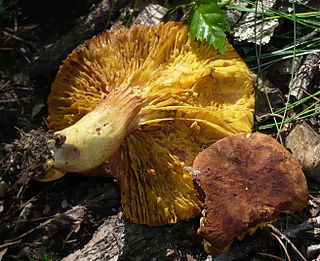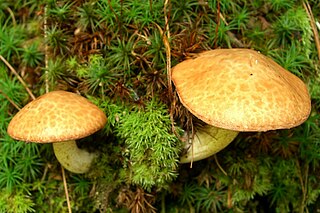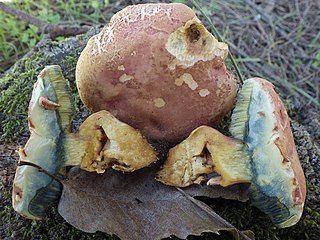
A bolete is a type of mushroom, or fungal fruiting body. It can be identified thanks to a unique mushroom cap. The cap is clearly different from the stem. On the underside of the cap there is usually a spongy surface with pores, instead of the gills typical of mushrooms. However, there are some boletes that are gilled, such as varieties of Chroogomphus, Gomphidius, Paxillus, Phylloporus and the Hygrophoropsis aurantiaca.

Xerocomus is a genus of poroid fungi related to Boletus. Many mycologists did not originally recognize the distinction between the two genera and placed Xerocomus taxa in genus Boletus. However, several molecular phylogenetic studies have demonstrated that Xerocomus is a heterogeneous genus of polyphyletic origin, which has resulted in further division of Xerocomus into Xerocomellus and Hemileccinum. The members of the genus Xerocomellus are more closely related to Boletus than true Xerocomus is, which is relatively distantly related to Boletus and more closely related to Phylloporus. Other former Xerocomus species have since been moved to Aureoboletus, Imleria, Hortiboletus and Rheubarbariboletus.

Petaurista is a genus of rodent in the family Sciuridae. They are large to very large flying squirrels found in forests and other wooded habitats in southern and eastern Asia.

Phylloporus is a genus of fungi in the family Boletaceae. The genus has a cosmopolitan distribution, and contains about 50 species, mostly in tropical areas.

Phylloporus rhodoxanthus, commonly known as the gilled bolete, is a species of fungus in the family Boletaceae. As suggested by its common name, the distinctive feature of this species is its yellow gills—an unusual feature on a bolete mushroom.
Phylloporus hyperion is a species of fungus in the family Boletaceae.
Phylloporus veluticeps is a species of fungus in the family Boletaceae.

Phylloporus pelletieri, commonly known as the golden-gilled bolete, is a species of fungus in the family Boletaceae.
Psiloboletinus is a fungal genus in the family Suillaceae. This is a monotypic genus, containing the single species Psiloboletinus lariceti, first described by mycologist Rolf Singer in 1938 as a species of Phylloporus. Alexander H. Smith disagreed with Singer's generic concept, concluding "No matter what disposition of the type species of Psiloboletinus is eventually made, it is evident that there are no clearly distinctive characters on which to recognize the genus on the basis of Singer's descriptions."

Suillus sibiricus is a fungus of the genus Suillus in the family Suillaceae. It is found in mountains of Europe, North America, and Siberia, strictly associated with several species of pine tree. Due to its specific habitat and rarity in Europe, it has been selected for inclusion in several regional Red Lists. Its fruit bodies are characterised by having slimy caps in wet weather, which can reach diameters of up to 10 cm (3.9 in). On the underside of the cap are yellow angular pores that bruise a pinkish to cinnamon colour. The stem is up to 8 cm (3.1 in) tall and 2.5 cm (1.0 in) wide and typically has a ring, a remnant of the partial veil that covers the fruit body in its early development. In North America, it is commonly called the Siberian slippery jack. Phylogenetic analysis has shown that S. sibiricus is closely related to S. umbonatus and S. americanus, and may in fact be conspecific with the latter species.
Phylloporus scabripes is a species of bolete fungus in the family Boletaceae. Found in Belize on sandy soil under Quercus spp. and Pinus caribaea, it was described as new to science in 2007.

Phylloporus arenicola is a species of bolete mushroom in the family Boletaceae. It is found in the Pacific Northwest region of western North America, where it grows in sand dunes in a mycorrhizal association with pine trees. It is one of only three North American Boletaceae species that occur in coastal sand dunes.

Phylloporus leucomycelinus is a species of bolete fungus in the family Boletaceae. First described in 1978, it is found in eastern North America and the Philippines.

Suillus subaureus is a rare species of bolete fungus in the family Suillaceae. It is found in North America, where it associates with deciduous trees. Originally described in 1887 by Charles Horton Peck, it was transferred to genus Suillus by Wally Snell in 1944. Fruitbodies are pale yellow—reflecting its specific epithet subaureus, which means "somewhat golden yellow". The spore print is olive brown. Spores are smooth and inamyloid, and measure 7–10 by 2.7–3.5 µm. It has also been recorded in Taiwan.

Rheubarbariboletus is a fungal genus in the family Boletaceae. Circumscribed in 2014, it contains two species found in Europe: Rheubarbariboletus persicolor, and the type, R. armeniacus. The generic name is derived from the Latin rheubarbarum, meaning "rhubarb", referring to the color of the flesh at the base of the stipe. The genus is closely related to Xerocomellus, but differs by having smooth spores, the unchanging yellowish to orange-rhubarb coloring of the stipe base, and the distinctive dark-green to black color reaction with iron sulphate on both the surface of the cap and on the flesh of the stipe.
Phylloporus gajari is a species of the fungal family Boletaceae. It was first described as a new species in 2015 from Bangladesh. This fungus is putatively associated with Shorea robusta.

Rheubarbariboletus persicolor is a species of bolete fungus. It was originally described in 1996 as Xerocomus persicolor, based on collections made in Italy. The bolete was found in mixed woodland with hop-hornbeam, pine, and oak.
Phylloporus attenuatus is a species of the fungal family Boletaceae. It was first described as a new species in 2017 from Bangladesh. This fungus is putatively associated with Shorea robusta.
Phylloporus catenulatus is a species of the fungal family Boletaceae. It was first described as a new species in 2017 from Bangladesh. This fungus is putatively associated with Shorea robusta.










